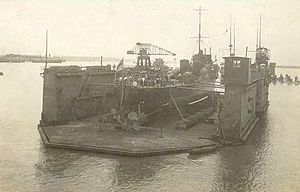HMS Doon (1904)
From SpottingWorld, the Hub for the SpottingWorld network...
 HMS Doon in a floating dock at Harwich during WWI | |
| Career (United Kingdom) | |
|---|---|
| Name: | HMS Doon |
| Builder: | Hawthorn Leslie Ltd, Newcastle |
| Launched: | 8 November 1904[1] |
| Fate: | Broken up in 1919 |
| General characteristics | |
| Class and type: | River- or E-class destroyer |
| Displacement: | 545 long tons (554 t) |
| Length: | 225 ft (69 m) |
| Beam: | 23 ft 6 in (7.16 m) |
| Draught: | 10 ft 10 in (3.30 m) |
| Propulsion: | Vertical triple expansion steam engines, 2 shafts |
| Speed: | 25.5 knots (29.3 mph; 47.2 km/h) |
| Complement: | 70 |
| Armament: |
|
HMS Doon was a River-class destroyer named after the River Doon, and the only ship of the Royal Navy ever to bear the name.
Pennant Numbers
| Pennant Number[2] | From | To |
|---|---|---|
| N14 | 6 December 1914 | 1 September 1915 |
| D16 | 1 September 1915 | 1 January 1918 |
| D27 | 1 January 1918 | 27 May 1919 |
Construction
She was built by Hawthorn Leslie and launched in 1904. She featured flush funnel tops, as did others of her class. She was 220 feet long, displaced around 550 tons and her 7,000 HP produced 26 knots.
Armament
She was armed with one twelve pounder and was later uprated with four. She carried two torpedo tubes.
Career
She served in home waters during the Great War and was sold to Ward of Rainham on 27 May 1919 for scrapping.[2]
References
- ↑ "HMS 'Doon at BattleshipsCruisers.co.uk". http://www.battleships-cruisers.co.uk/river_class.htm. Retrieved 2009-06-22.
- ↑ 2.0 2.1 ""Arrowsmith" List: Royal Navy WWI Destroyer Pendant Numbers". http://www.gwpda.org/naval/s0420000.htm. Retrieved 2009-02-03.
- The British Destroyer by Captain T.D. Manning. Published by Godfrey Cave Associates. ISBN 0 906223 12 x.
| |||||||||||||||||||||||
